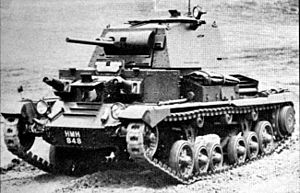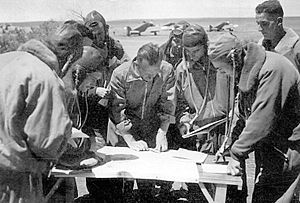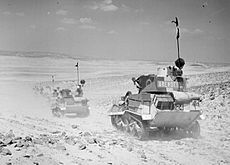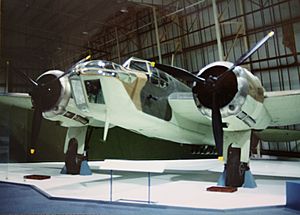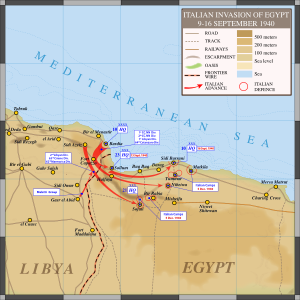Italian invasion of Egypt facts for kids
Quick facts for kids Italian invasion of Egypt |
|||||||||
|---|---|---|---|---|---|---|---|---|---|
| Part of the Western Desert campaign of the Second World War | |||||||||
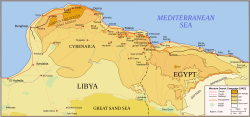 Western Desert 1940 |
|||||||||
|
|||||||||
| Belligerents | |||||||||
| Commanders and leaders | |||||||||
|
|||||||||
| Strength | |||||||||
| 4 divisions 300 aircraft |
1 reinforced brigade 205 aircraft naval support |
||||||||
| Casualties and losses | |||||||||
| 120 killed 410 wounded 6 aircraft |
40 killed 10 tanks 11 armoured cars 4 lorries |
||||||||
| The Kingdom of Egypt remained neutral for the duration of the war | |||||||||
The Italian invasion of Egypt was a major attack during World War II. It happened in September 1940, when Italy invaded Egypt from Libya. Italian forces, known as the 10th Army, aimed to capture the Suez Canal, a very important waterway.
The invasion started with border fights. The Italian army moved about 65 miles into Egypt. They faced British and Commonwealth forces, who were much smaller in number. On September 16, 1940, the Italian army stopped at Sidi Barrani and set up defenses. They planned to build a new road and gather more supplies before moving on.
The British had fewer casualties, with 40 men killed compared to Italy's 120. However, the Italian advance was a victory for them at the time. Later, in December, the British launched a surprise attack called Operation Compass. This attack pushed the Italian 10th Army back. Many Italian soldiers were captured, and a lot of their equipment was lost.
Why Did Italy Invade Egypt?
Italy's Colony in Libya
Before World War II, Libya was an Italian colony. It was located next to Tunisia (controlled by France) and Egypt (where Britain had a strong presence). Italy needed to protect its borders on both sides.
Italy had two main armies in Libya: the 5th Army in the west and the 10th Army in the east. These armies had many soldiers, but their equipment was often old or not enough. Italy's leader, Benito Mussolini, wanted to expand his empire. He ordered his generals to attack Egypt.
Britain's Position in Egypt
Britain had military forces in Egypt since 1882. They were there to protect the Suez Canal and the Red Sea route. These routes were vital for Britain to communicate with its territories in Asia and the Indian Ocean.
Egypt itself was neutral during the war. The British forces in Egypt were much smaller than the Italian forces in Libya. They had about 36,000 troops, while Italy had around 215,000. The British commander in the Middle East was General Archibald Wavell.
The British had a special unit called the 7th Armoured Division. This division was known for its tanks and mobility. They were tasked with defending the border and slowing down any Italian attack.
The Desert Battlefield
The area where the invasion happened was called the Western Desert. It's a very dry and stony place. The only paved road was the Via Balbia along the coast.
The desert has extreme temperatures, very hot days and cold nights. Strong winds called Sirocco (or Ghibli) can blow sand everywhere. This makes it hard to see and breathe. Moving vehicles and supplies like water and food was very difficult in this harsh environment.
Italian soldiers, especially those new to the desert, sometimes got lost. This showed how challenging the terrain was for military operations.
Italy's Army Challenges
Italy's army had recently been reorganized. They tried to make their divisions faster and more mobile. However, they lacked modern tanks, vehicles, and good communication equipment. Many of their divisions still had old gear.
Despite having many soldiers, their equipment was often inferior to what their enemies had. The Italian navy and air force also faced challenges. The navy had lost many submarines, and the air force wasn't able to keep up high levels of operations.
Italian generals, like Marshal Rodolfo Graziani, even told Mussolini that the army wasn't ready to invade Egypt. They needed more trucks, water tankers, and better tanks. But Mussolini ordered the attack anyway.
Planning the Attack
Italian Preparations
The Italian 10th Army, led by Lieutenant-General Mario Berti, was in charge of the invasion. They had ten divisions, but not all of them were fully motorized. This meant many soldiers would have to walk long distances.
The Italian air force, called Squadra 5, supported the army. They had many bombers and fighters. However, the Italian navy could not offer much help because they were short on fuel and didn't want to risk their ships.
Italy had several plans for the invasion, but they kept getting delayed. One plan was to capture Sollum and then move to Sidi Barrani. The final plan was to advance along the coast road to Sidi Barrani. The Italians believed they needed a large number of troops to defeat the British.
British Defense Strategy
The British Western Desert Force (WDF), led by Lieutenant-General Richard O'Connor, had about 10,000 men. They used small, mobile groups of soldiers, tanks, and artillery called "jock columns." These groups would patrol the border and attack Italian convoys.
The British strategy was to slow down the Italian advance. They would fight delaying actions, destroying roads as they retreated. This would make it harder for the Italians to bring up supplies. The main British force would wait at Mersa Matruh to counter-attack.
The British Royal Air Force (RAF) in the Middle East had fewer aircraft than the Italians. Many of their planes were older models. However, the British navy controlled the eastern Mediterranean Sea. This allowed them to bombard Italian positions along the coast and transport supplies.
Early Border Fights
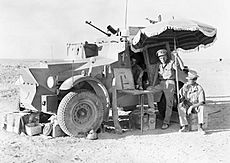
Before the main invasion, British patrols were very active along the border. They often surprised Italian troops who didn't even know war had been declared. For example, 70 Italian soldiers were captured on a track to Sidi Omar.
British patrols also captured Fort Capuzzo and an Italian general. These early skirmishes showed the British were ready to fight. By August, the British stopped some of their raids to save their vehicles from wear and tear. They focused on observing the border, ready to slow down any Italian invasion.
The Invasion Begins
Italian Advance (September 9–10)
On September 9, 1940, the Italian air force increased its activity. British RAF bombers responded by attacking Italian airfields and supply depots. British planes also saw a lot of Italian movement near the border, which signaled the start of the invasion.
The Italian 10th Army began its advance. However, some Italian units, like the Maletti Group, got lost in the desert. This showed how difficult it was for them to navigate. On September 10, British armored cars spotted the lost Italian group.
Pushing Towards Sidi Barrani (September 13–14)
On September 13, Italian forces recaptured Fort Capuzzo and occupied Musaid, just inside Egypt. They heavily bombed Sollum airfield, but it was empty. The Italian army then advanced along the coast road.
The British covering force, made up of Coldstream Guards and artillery, slowly retreated. They tried to inflict as much damage as possible on the advancing Italians. On the plateau, another Italian force moved towards Halfaya Pass. British units there also withdrew, fighting delaying actions.
The next day, Italian units descended through Halfaya Pass to join the forces on the coast road. British tanks and infantry harassed the Italians. The British continued to fall back, reaching Buq Buq and then Alam Hamid. They destroyed the coast road as they went, making it harder for the Italians to move.
Reaching Sidi Barrani (September 16)
On September 16, Italian tanks and motorized infantry tried to outflank the British at Alam el Dab, near Sidi Barrani. The Coldstream Guards were forced to retreat. By nightfall, the Italian 1st CC.NN. Division "23 Marzo" had occupied Sidi Barrani.
The British forces on the escarpment also fell back. British aircraft flew many reconnaissance and bombing missions. The Italian air force also conducted sweeps over British airfields.
The British expected the Italian advance to stop at Sidi Barrani, and it did. The Italians began to dig in and build defensive positions in an arc around Sidi Barrani. They planned to bring up more supplies before continuing their advance.
What Happened Next?
Who Suffered More?
The Italian invasion of Egypt resulted in fewer casualties for the British. Around 40 British soldiers were killed. They also lost some tanks, armored cars, and lorries.
The Italian 10th Army suffered more, with about 120 soldiers killed and 410 wounded. Several Italian tanks and lorries broke down, and six aircraft were lost.
After the Invasion
After the Italians stopped at Sidi Barrani, the British Mediterranean Fleet began to attack Italian supply lines. They mined Benghazi harbor and sank some Italian ships. RAF planes also destroyed Italian aircraft on the ground.
British naval ships bombarded Italian positions along the coast, causing damage and lowering morale. Small British ground columns also worked with armored car patrols. They moved close to Italian camps to gather information.
Operation Compass
On December 8, the British launched a major surprise attack called Operation Compass. This was a five-day raid against the fortified Italian camps outside Sidi Barrani. The attack was a huge success.
The Italian 10th Army units in Egypt were largely destroyed or forced to retreat quickly. The British pursued them along the coast, capturing towns like Sollum, Bardia, and Tobruk.
The British suffered about 1,900 casualties (killed and wounded). However, they captured an astonishing 133,298 Italian and Libyan prisoners. They also seized 420 tanks, over 845 guns, and many aircraft. The British could not continue their advance beyond El Agheila because their vehicles were worn out, and some of their best units were sent to help in the Greek Campaign.
Images for kids



